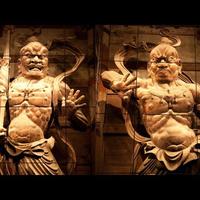運慶(46)
うん けい
Unkei
Unkei
Unkei (46).
Unkei (46)
Unkei (46).
Unkei (46).
Unkei (46).
运庆 (46)
運慶 (46)
こんにち は 人 から 分かる 3 分 美術 史 。
||じん||わかる|ぶん|びじゅつ|し
||person|||||
Today is 3 minutes of art history that people can understand.
今日 は 運 慶 に ついて 勉強 して いき ましょう 。
きょう||うん|けい|||べんきょう|||
||luck|celebration||||||
運 慶 。1151 年 頃 の 生まれ 。 平安 末期 から 鎌倉 初期に かけて の 仏師 であり 、
うん|けい|とし|ころ||うまれ|へいあん|まっき||かまくら|しょきに|||ぶっし|
|||||||||||||Buddhastatue- oder Buddha-Schnitzer|
fortune|Kei|||||Heian|late||Kamakura|early|||Buddhist sculptor|
Unkei was born around 1151. He was a Buddhist master from the late Heian period to the early Kamakura period,
写実 的な 仏像 の 様式 を 確立 した 人物 と して 知ら れ ます 。
しゃじつ|てきな|ぶつぞう||ようしき||かくりつ||じんぶつ|||しら||
||Buddha-Statue|||||||||||
realism||Buddha statue||style||established||person|||||
He is known as the person who established the style of realistic Buddhist images.
運 慶 は 鳥羽 上皇 が 院政 を 敷いて いた 時代 に 、
うん|けい||とば|じょうこう||いんせい||しいて||じだい|
|||Toba||||||||
|||Toba|retired emperor||regency|(object marker)|exercised|||
Unkei was born during the era when Emperor Toba was conducting the Cloistered Government.
仏師 である 康 慶 の 息子 と して 生まれ ました 。
ぶっし||こう|けい||むすこ|||うまれ|
Buddhist sculptor||Kō|Kei||||||
He was born as the son of the sculptor Kokei.
康 慶 は 、 はじめ 奈良 の 興福寺 を 拠点 と する 集団 ・ 奈良 仏師 に 属し ました が 、
やす|けい|||なら||きょう ふく てら||きょてん|||しゅうだん|なら|ぶっし||ぞくし||
||||||Kōfuku-ji|||||||||||
Kō||||Nara||Kōfuku-ji||base|||group|Nara|Buddhist sculptor||belonged||
Kokei initially belonged to the collective of sculptors based at Kofuku-ji in Nara.
1170 年 頃 より 独立 して 、 慶 派 と 呼ば れる 仏師 集団 を 創設 し ます 。
とし|ころ||どくりつ||けい|は||よば||ぶっし|しゅうだん||そうせつ||
|||independence||prosperity|||||Buddhist sculptor|group||establish||
Around 1170, he became independent and founded a group of Buddhist masters known as the Kei school.
しかし 円 派 ・ 院 派 ら 京都 を 拠点 と して いた
|えん|は|いん|は||みやこ||きょてん|||
|yen||school|||Kyoto||base|||
However, the En and In factions were based in Kyoto.
仏師 集団 に 比べて マイナーな 存在 で あり ました 。
ぶっし|しゅうだん||くらべて|まいなーな|そんざい|||
||||minor||||
Buddhist sculptor||locative particle|compared to|minor||||
Compared to the Buddhist groups, they were a minor presence.
運慶 は 康慶 の 嫡男 であり 、 後継者 と して 育ち ました 。
うん けい||こうけい||ちゃくおとこ||こうけい しゃ|||そだち|
||Kōkei||||Nachfolger||||
||||||successor||||
Unkei was the eldest son of Kokei and grew up to be his successor.
運 慶 の 最初 期 の 作品 と して 知ら れて いる の が 、 円成寺 大日 如来 坐像 です 。
うん|けい||さいしょ|き||さくひん|||しら|||||えん しげ てら|だいにち|にょらい|すわ ぞう|
||||||||||||||Enseiji|Daibutsu|Nyorai|Sitzstatue|
||||||||||||||Enjōji||Buddha||
Unkei's first known work is the seated statue of Dainichi Buddha at Enseiji Temple.
運 慶 25 歳 頃 の 作品 であり 、 当時 主流 の 単純化 ・ 理想化 さ れた 様式 である
うん|けい|さい|ころ||さくひん||とうじ|しゅりゅう||たんじゅん か|りそう か|||ようしき|
||||||||||Vereinfachung|Idealisierung||||
||||||||||simplification||||style|
It is a work by Unkei, who was around 25 years old, in the simplified and idealized style prevailing at the time.
定朝 様 と 比べ 写実 的な 布 の 表現 や 肉 感 的な 顔 が 特徴 と なって い ます 。
てい ちょう|さま||くらべ|しゃじつ|てきな|ぬの||ひょうげん||にく|かん|てきな|かお||とくちょう||||
Jōchō|||||||||||||||||||
Jōchō|||||||||||||||||||
Compared to the Sadacho style, the Sadacho style is characterized by a more realistic expression of the cloth and a more fleshy face.
1180 年 、 平 清盛 の 命 に よって 東大寺 ・ 興 福 寺 が 焼き討ち に 遭い ます 。
とし|ひら|たいら||いのち|めい||とうだいじ|きょう|こう|てら||やきうち||あい|
|||||||Todai-ji|||||Brandanschlag|||
|Taira|Taira no Kiyomori||order|||Todai-ji|||||arson||suffered|
In 1180, Todaiji and Kofukuji temples were burned to the ground under the orders of Taira no Kiyomori.
間も無く 清盛 が 亡くなる と 、 朝廷 は 藤原 兼光 を 長官 と して 、
まもなく|きよもり||なくなる||ちょうてい||ふしわら|かねみつ||ちょうかん||
|Kiyomori|||||||Kanemitsu||||
|Taira no Kiyomori||||imperial court|topic marker|Fujiwara|Kanemitsu||chief||
When Kiyomori died soon after, the court appointed Fujiwara no Kanemitsu as chief minister,
興 福 寺 の 再興 に 乗り出し ます 。
こう|ふく|てら||さいこう||のりだし|
||||reconstruction||will embark on|
He embarked on the rebuilding of Kofukuji Temple.
そこ で 運 慶 は 、 父 ・ 康 慶 ら と ともに 存在 感 を 発揮 し ました 。
||うん|けい||ちち|やす|けい||||そんざい|かん||はっき||
||||||Kō||||||||demonstrated||
There, Unkei was a prominent figure, along with his father Kangkei and others.
続いて 、1185 年 に 壇ノ浦 の 戦い で 平家 が 滅亡 する と 、
つづいて|とし||だんのうら||たたかい||へいけ||めつぼう||
|||Dan-no-ura||||Heike||||
|||Dan-no-ura||||Heike||destruction||
The Heike clan was destroyed in the battle of Dannoura in 1185,
運 慶 へ の 依頼 主 に は 、 北条 時 政 ・ 和田 義盛 ら 、
うん|けい|||いらい|おも|||ほうじょう|じ|まつりごと|わだ|よしもり|
||||||||Hōjō||||Yoshimori|
fortune||||request|client|locative particle||Hojo|Toki|politics|Wada|Yoshimori|
Clients of Unkei included Hojo Tokimasa and Wada Yoshimori,
鎌倉 幕府 の 重鎮 が 増えて いき ます 。
かまくら|ばくふ||じゅうちん||ふえて||
Kamakura|shogunate||important person||||
The heavyweights of the Kamakura shogunate are increasing.
運 慶 の 作品 を 見て いき ましょう 。 運 慶 の 代表 作 と して 知ら れる の が 、
うん|けい||さくひん||みて|||うん|けい||だいひょう|さく|||しら|||
Let's take a look at Unkei's works. One of Unkei's representative pieces is the
東大寺 金剛 力士 像 。 高 さ 8 メートル を 超える 巨像 であり 、
とうだいじ|こんごう|りきし|ぞう|たか||めーとる||こえる|きょぞう|
|Vajra|warrior|statue|||||exceeds|giant statue|
Great Kongo Rikishi statues of Todai-ji. They are giant statues over 8 meters tall,
運 慶 、 弟 の 定 覚 、 息子 の 湛慶 、 そして 運 慶 と 並ぶ 名 仏師 である 快 慶 の
うん|けい|おとうと||てい|あきら|むすこ||たんよし||うん|けい||ならぶ|な|ぶっし||こころよ|けい|
||||||||Zan Kei|||||||||||
||younger brother||settled|awakening|||Zentake||||||||||Kō|
Unkei, his younger brother Sadakaku, his son Tankei, and Kaikei, who was as famous a Buddhist master as Unkei.
4 人 が 中心 と なり 、1203 年 に 作り上げ ました 。
じん||ちゅうしん|||とし||つくりあげ|
||center||||||
It was built in 1203 by a group of four men.
写実 的な 筋肉 の 表現 や 勢い の ある 布 の 描写 が 特徴 です 。
しゃじつ|てきな|きんにく||ひょうげん||いきおい|||ぬの||びょうしゃ||とくちょう|
||muscle||||force|||fabric||depiction|||
The realistic muscularity and vigor of the fabrics are characteristic of this work.
興 福 寺 無 著 菩薩 ・ 世 親 菩薩 像 。
きょう|ふく|てら|む|ちょ|ぼさつ|よ|おや|ぼさつ|ぞう
|||without|attached|bodhisattva|world|parent|bodhisattva|
The statue of Kōfuku-ji is of the bodhisattva Shojin.
肖像 彫刻 と して も 日本 史上 の 傑作 と して 知ら れ ます 。
しょうぞう|ちょうこく||||にっぽん|しじょう||けっさく|||しら||
portrait|sculpture|||||||masterpiece|||||
It is known as a masterpiece in Japanese history as a portrait sculpture.
1203 年 、 運 慶 は 僧侶 と して 最高の 位 である 法 印 に 就任 。
とし|うん|けい||そうりょ|||さいこうの|くらい||ほう|いん||しゅうにん
||||Buddhist monk|||highest|position||seal|seal|locative particle|assumed office
In 1203, Unkei was appointed to the highest rank of a monk, known as the Hōin.
奈良 仏師 と して は 初 の 快挙 であり 、 名実ともに 当代 最高 の 仏師 と して 知ら れる ように なり ます 。
なら|ぶっし||||はつ||かいきょ||めいじつともに|とうだい|さいこう||ぶっし|||しら||||
|||||||Meisterwerk|||||||||||||
|||||||great achievement||both name and reality|present||||||||||
This was a remarkable achievement for a sculptor from Nara, and he became known as the foremost sculptor of his time, both in name and reality.
その後 武士 の 力 が 強まって いく に 従い 、
そのご|ぶし||ちから||つよまって|||したがい
|warrior||power||strengthened|||as
After that, as the power of the warriors grew stronger,
京都 を 拠点 と して いた 円 派 ・ 院 派 は 全国 に 散逸 し 、 慶 派 の 勢力 が 拡大 。
きょうと||きょてん||||えん|は|いん|は||ぜんこく||さんいつ||けい|は||せいりょく||かくだい
|||||||||||||verstreut|||||||
||base|||||||||||scattered|||||power||expanded
The En and In factions based in Kyoto were scattered throughout Japan, and the Kei factions expanded their influence.
運 慶 は 1224 年 に 亡くなる まで 、
うん|けい||とし||なくなる|
Unkei until his death in 1224,
江戸 期 まで 続く 慶 派 の 礎 を 築いた のでした 。
えど|き||つづく|けい|は||いしずえ||きずいた|
|||||||foundation||built|
He laid the foundation for the Kei school, which continued until the Edo period.
以上
いじょう
... and upwards

